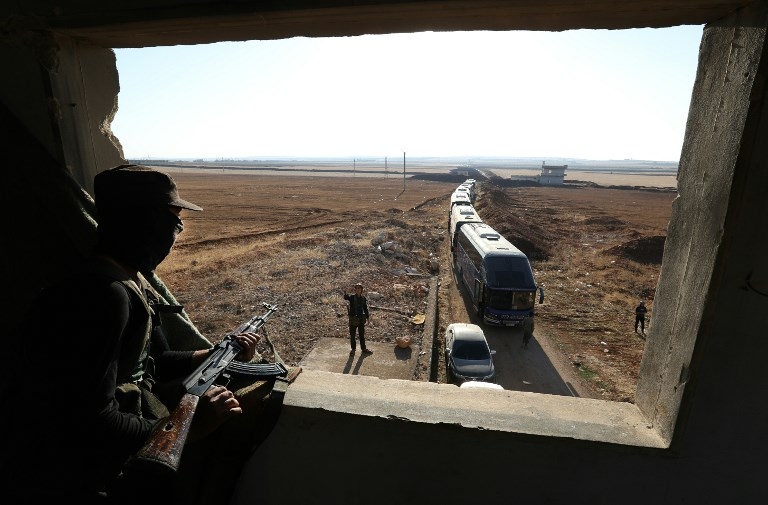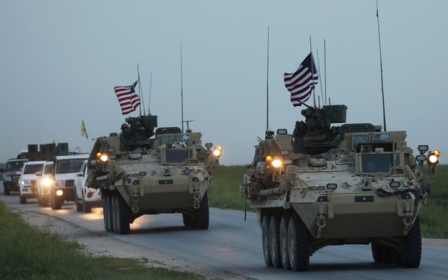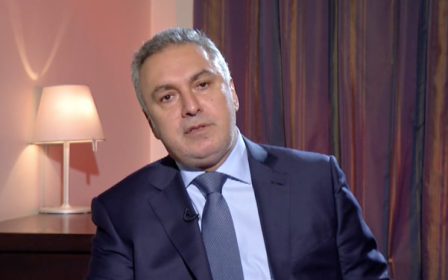'This house isn't mine': Syrians uneasy over occupying homes of displaced

AMMAN - Sometimes the buses would depart Abu Ali’s besieged village with groups of his neighbours on board. Other times, they merely idled in wait before turning back, empty, across the front lines.
Each time, the buses served as a reminder that the fates of Abu Ali’s hometown, Fuaa, and the neighbouring village of Kafraya - two previously government-held, Shia-majority villages in the heart of rebel-held Idlib province - were being decided elsewhere, a bargaining chip in complex negotiations that would ultimately involve just about every actor involved in the Syrian conflict.
“We heard a lot about breaking the siege,” Abu Ali, a former schoolteacher, tells Syria Direct. “Sometimes it turned out to be untrue, and sometimes prisoners were released instead of us.”
I’d leave and return to my own home [in Homs], no matter how destroyed it is. In the end, this house isn’t mine. It’s not my right to be here
- Yahya al-Homsi, Fuaa resident
By September 2015, the two Idlib towns had become the focus of the “Four Towns Agreement,” an opaque arrangement negotiated by a dizzying array of armed actors and their regional backers - among them, the Syrian government’s allies Iran and Lebanese Hezbollah, as well as hardline Sunni rebels and their Qatari sponsors.
The deal linked Fuaa and Kafraya with two rebel-held, Sunni-majority towns - Zabadani and Madaya, in outer Damascus. Zabadani and Madaya were also besieged at the time, but by pro-government forces. Madaya’s siege in particular attracted international outcry as civilians were subjected to mass starvation and disease.
According to initial talks, the Four Towns Agreement stipulated that whatever developments took place in one of the four designated towns would be replicated in the other three: meaning parallel ceasefires, evacuations of emergency medical cases as well as deliveries of much-needed humanitarian aid. When evacuation buses left Fuaa and Kafraya, convoys would depart from Madaya or Zabadani as well.
A later iteration of the deal, in early 2017, called for simultaneous evacuations of residents and fighters from all four towns, in what was seen by many observers as part of a plan to enact demographic change in communities dotted around the country.
But while some aid reached the besieged pockets under the deal, and thousands of people were eventually brought out, the Four Towns Agreement would ultimately be characterised more for its dysfunction - and the backroom dealings that dictated conditions - than its successes.
Killed as they left
Multi-stage evacuations were often delayed or simply called off, while tit-for-tat violence repeatedly broke out. In April 2017, a suicide bomber attacked a convoy of evacuation buses shortly after leaving Fuaa and Kafraya, killing 126 people, including 68 children, and injuring hundreds more.
For those left behind, conditions within Fuaa and Kafraya deteriorated. Thousands relied on intermittent government airdrops for small amounts of essentials like food and fuel while reserves dwindled and eventually disappeared. Each week, a different item parachuted down - salt, bread, sugar.
Civilians still besieged in Fuaa and Kafraya, among them Abu Ali, could do little but wait. Each time word of a potential evacuation broke, they would quickly gather together belongings, say their goodbyes and prepare to depart.
“For months, we would get ourselves ready to leave, only to come back [home] later,” he says.
It was as if we had been in prison, and then emerged to the world outside
- Abu Ali, former resident of Fuaa
Finally, one night in July last year, a convoy of 121 buses - accompanied by the Syrian Arab Red Crescent (SARC) - evacuated some 7,000 remaining residents from the two towns towards a transit centre in the rural Aleppo village of Jabrin.
Hundreds of detainees held in government detention facilities were simultaneously released in the exchange, this time negotiated between al-Qaeda-linked militant faction Hay’at Tahrir a-Sham (HTS) and the Syrian government.
“It was as if we had been in prison, and then emerged to the world outside,” Abu Ali says.
While the three-year rebel siege came to an end, evacuees were thrust into unfamiliar conditions outside Idlib, their homes left unoccupied and subject to the whims of rebel groups that came in to rule the area they had long blockaded.
Six months later, testimonies from the now-repopulated villages of Fuaa and Kafraya as well as coastal Latakia province - where many of the villages’ original residents ended up - reveal two disparate communities linked through cycles of displacement that continue to reverberate across Syria.
Houses are vacated, before new occupants move in.
“We’ve had no news of our homes,” Abu Ali reflects, “but we knew that other people would start living in them after we left.”
Ghost towns return to life
With the two Idlib towns emptied, and all 7,000 remaining residents displaced, rebel factions quickly moved in.
Fuaa and Kafraya were declared a military zone by a handful of factions, including HTS and current rival Ahrar al-Sham, that seized control immediately after evacuations were completed last July.
At first, civilians in the area were forbidden from entering the two towns as various rebel groups established themselves and took on responsibility for clearing mines that had been planted between pockmarked buildings and piles of rubble near former front lines.
Within weeks, however, families - mostly relatives of local fighters, or those with the necessary connections - began to trickle in and occupy what were by then little more than “ghost towns”, according to Yahya al-Homsi, who now lives on the outskirts of Fuaa after being displaced last year.
Residents have nothing left. Some don’t have enough money to pay for a bag of bread
- protester in video
Al-Homsi left a formerly besieged rebel-held pocket in northern Homs to Idlib province in May, when his hometown submitted to forcible evacuations after years living under siege conditions, including scarce medical supplies, food shortages and sporadic bombardment by pro-government forces.
Many of the new arrivals to Fuaa and Kafraya were also displaced Syrians who, like the original owners of the houses they now inhabit, had boarded buses that brought them from the depths of crippling sieges to unfamiliar reaches of the country.
When he relocated to Fuaa, al-Homsi says, the towns were “not suitable for living at all”. The house he chose on the outskirts of Fuaa had been looted along with many others: the windows and doors long gone, even the pipes stripped away.
Since then, he adds, the towns have slowly come back to life. Rubble has been cleared, homes repaired bit by bit by new residents. A bakery, clothing shops and markets are now open for customers.
“Once civilians came in, the area started to flourish again,” al-Homsi says.
But, like other areas of Syria where property seizures have followed in the footsteps of those forced from their homes, Fuaa and Kafraya now face disputes over who holds the rights to repossessed homes and shops.
In recent weeks, demonstrations have cropped up across the towns as residents protest against purported demands from various ruling factions - reportedly including HTS and the Turkish-backed National Liberation Front - to either evacuate homes or pay exorbitant rents to fighters who had initially distributed the abandoned properties at no cost.
According to current residents - many of them displaced from formerly rebel-held East Ghouta, Daraya, northern Homs and beyond - interference from factions came as an unwelcome surprise, especially after many had invested personal funds to do repairs on damaged buildings or shops, expecting to stay, at least for the foreseeable future.
In one video published by local media in December, a protester speaks to camera while holding a sign reading “enough oppression”.
“Residents have nothing left,” he says. “Some don’t have enough money to pay for a bag of bread.”
‘This house isn’t mine’
Homes and property throughout the country have changed hands, sometimes repeatedly, amid concentric displacements and evacuation deals initiated across Syria.
In Syria’s northwestern Idlib province alone, nearly one half of a total estimated population of around three million people are displaced.
Although an all-out government offensive to expel rebels from Syria’s northwest was stalled in September following a last-minute “buffer zone” agreement brokered by Russia and Turkey, recent HTS advances across the northwest have thrown the agreement into doubt - and with it a period of uneasy calm in Idlib.
In the middle of it all, displaced families are now trying to make a life in Fuaa and Kafraya. But one question still looms large in the background: What about the original owners?
Al-Homsi says that he is prepared to turn his home over to its rightful owners should they one day come back.
“I’d leave and return to my own home [in Homs],” he says, “no matter how destroyed it is.”
“In the end, this house isn’t mine. It’s not my right to be here.”
Fellow Fuaa resident Um Ahmad, originally from East Ghouta, appears to have had no qualms about taking up residence in an appropriated home there - the original owners were “against us”, she says - though the mother of two still shelters the former residents’ untouched possessions in a closed-off room in the house.
Even so, when asked if she has any information about the former owners of the home she’s now living in, Um Ahmad replies indignantly: “No... why? Does anyone know whose home they’re occupying?
“We haven’t been in contact. It’s impossible.”
‘We just wanted to be safe’
Nowadays, former Fuaa teacher Abu Ali spends his days after displacement in al-Baseet, a resort town on far northwestern Syria’s Mediterranean coastline.
While Fuaa and Kafraya’s residents were scattered across government-held areas of Syria - to Aleppo, Homs province as well as Sayeda Zeinab in the southern outskirts of Damascus - hundreds have also been relocated by the Syrian government across the coastal mountain ranges that separate rebel-held Idlib province from majority-Alawite Latakia.
There, in the Syrian government’s traditional heartland, evacuees from Fuaa and Kafraya are largely concentrated in two resort towns - al-Baseet, where Abu Ali lives, and also Slinfah, in the peaks east of Latakia city.
After arriving to Latakia province, the Syrian army and aid organisations - including SARC - distributed housing and basic goods such as food, medicine and blankets to the evacuees. Children were quickly registered in local schools, and the sick were taken to hospitals for long-awaited treatment.
At first, the new arrivals largely stayed at home. “Nobody was working,” says Abu Bilal, who headed to Slinfah after being displaced from Fuaa. “We just wanted to be somewhere safe, and have our children in school.”
With time, however, displaced families have begun to search for work in local shops or using former trades. Others - Abu Ali included - joined the pro-government National Defence Forces militia in the hope of a small, but vital, salary.
We need what every person needs to live, and to provide a living for their family. We want homes, we want work. We want to return
- Abu Ali, former Fuaa resident
While work isn’t always hard to find in an area of the country where public services, housing and infrastructure have been put under strain by a swelling population, life in Latakia is a far cry from the political and religious tensions that had characterised life back home.
“It’s enough that [in Latakia] no one knows which sect you’re from,” Abu Ali says. “Sectarianism is what got us here.”
In Latakia, he says, they can “live like everyone else”.
Still, some fear it won’t last.
Families from Fuaa and Kafraya still receive rent assistance from the Syrian government, but Abu Ali is unsure how much longer that will continue - and displaced families from Aleppo living in al-Baseet prior to his arrival were instructed, then forced, to head back to Aleppo.
“We were told the [current] situation is temporary,” Abu Ali says, “and that we’ll later move to homes in the suburbs.”
“But how are we supposed to pay for that? We’re barely getting by as it is.”
The uncertainty around housing has contributed to feelings of instability shared by fellow Fuaa evacuee Abu Bilal, who worked as a plumber back in Idlib.
“We don’t feel like we can find normalcy here,” Abu Bilal says. “These aren’t our homes; it’s not our city.”
“We need what every person needs to live, and to provide a living for their family,” he continues. “We want homes, we want work. We want to return.”
Yet as long as the fragile calm in rebel-held Idlib holds - providing space for new residents to rebuild and settle themselves in Fuaa and Kafraya - prospects of return for the towns’ displaced currently look bleak.
From al-Fuaa to Latakia, Abu Ali has found himself waiting once more, unsure if he will ever go home.
“We’re afraid that this is it,” he says. “It seems there’s no end in sight.”
Read the original article on Syria Direct. Follow Syria Direct on Twitter.
Middle East Eye propose une couverture et une analyse indépendantes et incomparables du Moyen-Orient, de l’Afrique du Nord et d’autres régions du monde. Pour en savoir plus sur la reprise de ce contenu et les frais qui s’appliquent, veuillez remplir ce formulaire [en anglais]. Pour en savoir plus sur MEE, cliquez ici [en anglais].







